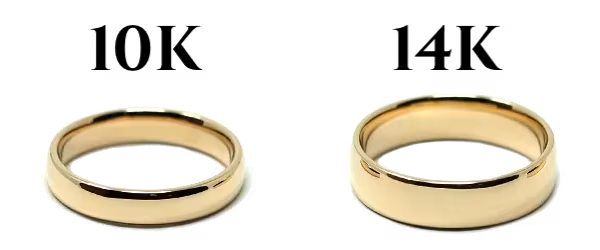10kt Gold vs 14kt Gold
Introduction – More Than Just a Number
When it comes to fine jewelry, choosing between 10kt gold vs 14kt gold is more than just comparing numbers on a chart – it’s about finding the metal that tells your story. Whether you’re shopping for gold engagement rings that symbolize your forever love or a timeless heirloom to pass down, the decision influences not just beauty, but also how your jewelry will live with you over the years.
Many buyers assume that a higher karat automatically means better quality. In reality, the difference between 10k vs 14k gold is about balance – balancing purity with durability, price with prestige, and sparkle with practicality. Just as no two love stories are the same, your perfect gold may not be the same as someone else’s.

What Does ‘Karat’ Mean in Gold?
Karat (kt) measures the proportion of pure gold in an alloy, with 24kt being pure gold. The rest is made up of metals like copper, silver, nickel, or zinc, which influence strength, color, and wearability.
- A higher karat means the gold contains a greater percentage of pure gold.
- Lower karats contain more alloy metals, making them harder and more resistant to scratches.
- The karat affects the gold’s color—richer in higher karats, paler in lower ones.
- Purity can also impact price, with higher karats generally costing more.
To learn more about how purity shapes the character of your jewelry, explore our detailed gold purity guide.
10kt Gold – Overview & Key Traits
10kt gold contains 41.7% pure gold and 58.3% alloy metals, making it the most durable and scratch-resistant among commonly used gold types. Its pale yellow hue is subtle, making it a versatile choice for everyday wear.
This metal is ideal for active lifestyles and budget-conscious buyers who still want the prestige of owning real gold. 10k gold jewelry is often chosen for men’s rings, casual gold pieces, and sturdy designs that can withstand daily wear without losing shape or shine.
14kt Gold – Overview & Key Traits
14kt gold contains 58.3% pure gold, which gives it a richer, warmer tone compared to 10kt. It strikes a beautiful balance between durability and luxury, making it the most popular choice for engagement and wedding rings.
With 14k gold jewelry, you’ll get a deeper golden color that stands out while still being strong enough for daily wear. It’s often the go-to for buyers who want something special for life’s most meaningful moments without stepping into the higher cost of 18kt gold.
10kt Gold vs 14kt Gold – Side-by-Side Comparison
Feature | 10kt Gold | 14kt Gold |
Gold Content | 41.7% | 58.3% |
Color | Paler yellow | Rich, warm yellow |
Durability | Very high (more alloy metals) | High (slightly softer than 10kt) |
Price | More affordable | Higher, due to more pure gold |
Ideal For | Everyday wear, active lifestyles | Engagement/wedding rings, luxury pieces |
The choice between 10kt gold vs 14kt gold depends on whether you prioritize maximum durability and affordability, or a richer hue and a touch more prestige
Durability & Wearability
When it comes to everyday resilience, 10kt gold has the edge. With its higher alloy content, it resists scratches, dents, and bending – making it perfect for hands-on professions or active lifestyles.
On the other hand, 14kt gold is still very durable and strong enough for daily wear but offers slightly more softness, allowing jewelers to create intricate, detailed designs. If you’re investing in durable gold engagement rings that will be worn daily for decades, both can work – your lifestyle will guide the choice.
Color & Aesthetic Appeal
The first thing you’ll notice is the color difference. 14kt gold has a warmer, richer yellow that many associate with luxury, while 10kt gold has a softer, lighter hue.
Your skin tone and style play a role here. Deeper, warmer skin tones often pair beautifully with 14kt gold’s richer glow, while fairer or cooler undertones may find the paler 10kt gold more flattering. For a closer look at warm yellow hues, browse our yellow gold rings.
Price & Value Considerations
The 14k gold price difference comes from its higher pure gold content, making it more expensive than 10kt. However, it’s often considered the “sweet spot” for balancing luxury and cost.
10kt gold offers the best budget-friendly entry into fine jewelry, making it perfect for buyers who want real gold without overspending. Resale value typically favors higher purity, but both 10kt and 14kt hold value due to their intrinsic gold content.
Choosing the Right Gold for Your Jewelry
Here are the key factors to consider:
- If you lead an active lifestyle, 10kt gold may offer the durability you need.
- If your budget allows for a little extra, 14kt gold gives you a richer look and higher purity.
- If you have sensitive skin, 14kt gold may be better since it has fewer alloy metals.
- If you want a balance of beauty and practicality, 14kt is a popular choice, while 10kt is great for affordability.
You can shop gold jewelry in both purities to see how each feels in person.
Shopping Smart
No matter which purity you choose, buy from a trusted jeweler. Always look for hallmark stamps that indicate purity, such as “10k” or “14k,” to guarantee authenticity. Consider warranties or maintenance services to protect your investment.
If you’re looking for something truly personal, custom gold rings allow you to choose the perfect karat, style, and design details to suit your story.
Conclusion – Finding Your Perfect Match
Your choice between 10kt and 14kt gold isn’t about right or wrong – it’s about finding the perfect partner for your lifestyle, budget, and style. Whether you choose the durability and value of 10kt or the richer color and balanced luxury of 14kt, the right gold will become a part of your life’s most treasured moments.
Shop 10k Gold Jewelry | Shop 14k Gold Jewelry
